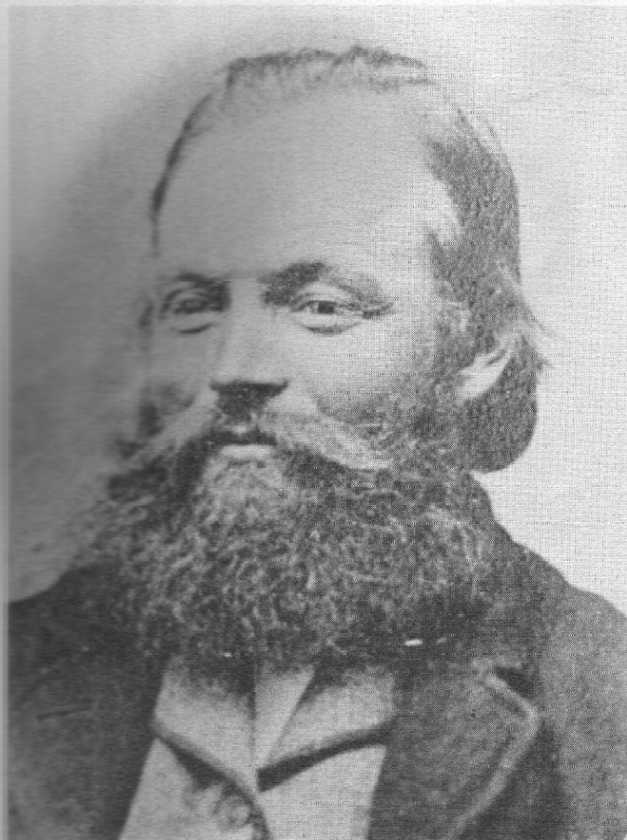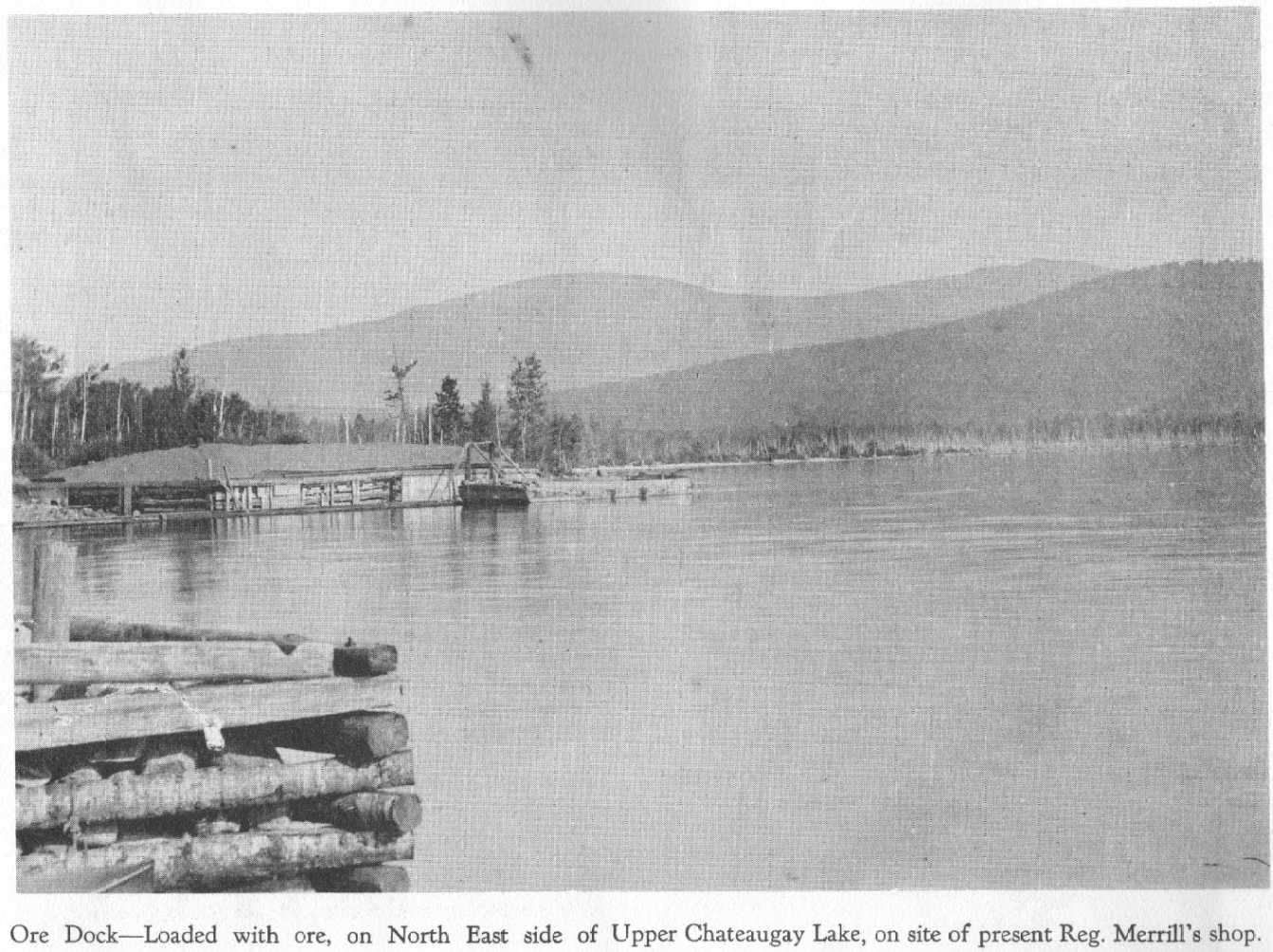Mining for Souls
Page 64 = 93
 Merrill
Merrill
 Darius W. Merrill-Founder of Merrill, N. Y.
In1875, when St. Bernard's Parish, Lyon Mountain,
came into being, Merrill was not yet known by that name. According to one
of Darius Merrill's old hotel registers, the area was called Rogersfield.
Darius W. Merrill-Founder of Merrill, N. Y.
In1875, when St. Bernard's Parish, Lyon Mountain,
came into being, Merrill was not yet known by that name. According to one
of Darius Merrill's old hotel registers, the area was called Rogersfield.
In the winter of 1877, Charles Merrill, son of
Darius, learned how to form a post office from a textbook on government.
With the help of his father, he wrote to the Postmaster General in Washington,
D. C., and in due time received and returned the necessary forms to establish
a fourth class post office at Merrill, New York.
By 1877, my great grandfather, Darius Merrill,
had lived at the (Chateaugay) lake, at least part of the time, for about
six years. He had had a camp there for some years. The first was of bark
and a later one of logs. Until 1877, he moved back to his home on the
lower lake each fall; however, in that year he moved up for good.
I cannot discover the exact date when Jean Baptiste
Gadway built his cabin on the west side of the Chateaugay Narrows, just north
of the sandbar, but from stories I've heard, it's evident that he was permanently
settled there some nine years before Darius Merrill hove in sight.
This gentleman, of French extraction, came into
the area from Canada; as did many of the early settlers and some not so early.
His great grandson, our friend and neighbor, Archie Gadway, tells me that
he was a tradesman who made, among other things, church windows.
Mr. Gadway has many descendants throughout the
north country. In the four generations since his time, each has had
a John Gadway. The present one, and fifth in a row, is a doctor, whose
practice is in the vicinity of Miami, Florida. Jean Baptiste's grandson,
John M. Gadway, was my Godfather when I was baptized.
Among the other French-Canadian emigrants to settle
in this area was Francis (Frank) Furness. He and three of his brothers were
tradesmen who were good at building log buildings. One of those built
by them was an annex to the old Merrill house called the Angel house.
Mr. Furness was also a farmer, a teamster in the lumber woods, and my maternal
grandfather.
This writer is also a tradesman who, in the tradition
of his forebears, repaired and built several boats He owns and operates
a small shop on the exact location of the ore dock, which, in 1875, was where
iron ore drawn from the Lyon Mountain mine by teams of horses, was loaded
by hand onto barges. These barges were poled and, when the wind was favorable,
they sailed to the dam about a mile north of the lower Chateaugay Lake.
At that location, Popeville, was the world's largest
catalan forge. The ore was made into billets (I think this is what they were
called), and then hauled to Chateaugay to the railroad. In about the last
half of this twenty-odd year operation, the steam tug, Maggie, towed the barges
up and down the lakes.
One must assume that many times the load on the
barges was charcoal from the two banks of kilns which were situated near the
narrows. One of these kilns, the Tatro Kiln, was located just slightly north
and straight across the narrows from the present Hollywood Inn. Remnants
of brick and the iron bands used to reinforce these beehive-shaped structures
can still be found where they once stood.
The other and larger bank of kilns was located
on the east side of the narrows, just a bit north of Henry Gonyea's farm.
The lakeshore property where they once stood reducing wood to charcoal is
now occupied by several camps. Among these are camps owned by Edward
Hoit, Leonard Prior, John Morgan, and others. The only trace of these, the
Tafaw Kilns, is under
the sod. I'm told, when one digs a hole in this area, he is quite apt to
find charcoal. As can be imagined, feeding these kilns kept many men busy
chopping down suitable trees. Teams of horses were busy hauling
wood from the surrounding area.
I must not leave the wrong impression; that is,
that these two sets of kilns were the only ones to supply the forge. There
were White's kilns, Blair's kilns, Middle kilns and I'm sure I've left out
a set or two which don't come to mind at the moment.

Since the roads in the area in those days ran
from horrible to non-existent, the main job of transportation was done by
steamboats. These were apparently fairly good-sized craft of forty to fifty
feet in length and eight to ten feet in the beam. I will not attempt
to name them in order of their appearance on the scene, but these are the
names I have heard: Nellie Tupper,
Maggie, Adirondack, Emma. The Nellie Tupper was, I think, brought here by
a Captain Tupper who built a hostelry which later became known as Sunset
Inn. The Maggie towed ore barges as has already been mentioned.
The Adirondack, first called the Reindeer, was
built in Champlain, cut into four sections, moved to Chateaugay Lake and
reassembled. The Emma, first run by steam and later by gasoline, was operated
by Paul Merrill and sons. She hauled passengers, supplies and mail
on the Chateaugay Lakes for many years. She was also the last of these
boats to see service on the lakes and seems to have been retired in about
1916.
Herbert McCoy of Chateaugay, whose family has had
a camp on Field's Bay for many years, told me a story involving the Emma.
Herb's father drove his family to the Banner House at the north end of the
Lower Lake with a horse and buggy. He would make arrangement with the Chases,
who owned this hotel, to leave the horse in their good care for the weekend.
The family would then board the Emma and ride to their camp where they would
be put ashore at their own dock, there to enjoy the type of quiet weekend
one can only imagine with envy now. When it came time to depart, the McCoy's
would watch for the Emma to go up the lake. After she was out of sight, a
white flag would be placed in a prominent location. On the return trip, the
operator, who would be looking for this signal at every landing, would see
it and stop and pick them up for the return trip to the Banner House.
Sources:
Adirondack Museum photos, Blue Mountain Lake, NY;
History of Clinton County, New York;
from History of Mining of Chateaugay
Ore and Iron Company.
Go to Page 1 of The History of Lyon
Mountain.
Go to Page 3 of The History of Lyon
Mountain.
Go to Mining History for The History
of Mining in the North Country.
Go to Page 5 of The History of Lyon
Mountain.(for article on Lyon Mt. and Mineville)
Go to Page 65 of Mining for Souls.
Back to Page 63 of Mining for
Souls.
Go to Page 1 of Mining for Souls.(cover
page)
 Rod Bigelow
Box 13 Chazy Lake
Rod Bigelow
Box 13 Chazy Lake
Dannemora, N.Y. 12929
 rodbigelow@netzero.net
rodbigelow@netzero.net  BACK TO
THE HISTORY PAGE
BACK TO
THE HISTORY PAGE
 BACK TO
BIGELOW HOME PAGE
BACK TO
BIGELOW HOME PAGE




